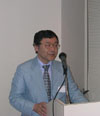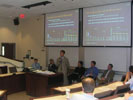GLOCOM-USC-JETRO Mobile Conference: July 16, 2003
Takahiro MIYAO (Professor, GLOCOM)
[GLOCOM/USC/JETRO Conference]
| Mobile Markets in Asia and the US |
| Date/Time: | July 16 (Wednesday) 14:00-16:30 |
| Place: | Marshall School of Business (JKP 204), University of Southern California, Los Angeles |
| Moderators: | Takahiro Miyao (GLOCOM) & Elizabeth Fife (CTM, USC) |
| Program: |
14:00-14:10
Takahiro Miyao (GLOCOM) - Opening Remarks
[Video ( 256K, 56K)]
14:10-14:20
Elizabeth Fife (CTM, USC) - Introduction
[Video ( 256K, 56K)]
14:20-15:20 Presentations by Speakers/Panelists:
Jin Woo Kim (Yonsei University/UCI) - Korea
[Video ( 256K, 56K)]
Michael Thuresson (Nikkei Electronics Asia) - Japan
[Video ( 256K, 56K)]
Joe Jasin (Wireless Blueprint) - China
[Video ( 256K, 56K)]
Tapio Anttila (Brauning, LLC) - Europe and US
[Video ( 256K, 56K)]
Scott Jensen (Mforma) - US and Asia
[Video ( 256K, 56K)]
15:30-16/30 Panel Discussion by Speakers/Panelists:
Greetings by Omar El Sawy (CTM, USC)
Moderated by Takahiro Miyao and Elizabeth Fife
Part 1 [Video ( 256k, 56k)]
Part 2 [Video ( 256k, 56k)]
(followed by the JETRO seminar on a similar topic at JETRO-LA from 18:00)
|
Background:
 As a sequel to the GLOCOM-USC-JETRO Mobile/Wireless Forum at the University of Southern California in Los Angeles on September 21, 2002 (http://www.glocom.org/special_topics/activity_rep/ As a sequel to the GLOCOM-USC-JETRO Mobile/Wireless Forum at the University of Southern California in Los Angeles on September 21, 2002 (http://www.glocom.org/special_topics/activity_rep/
200210_miyao_la/), we held a conference on the International Comparisons of Mobile Internet Markets at USC, which was followed by an evening seminar at JETRO-Los Angeles on July 16, 2003. At this conference we explored the current state and future prospects for mobile Internet markets in Asia and the U.S. Five specialists in mobile communications made brief presentations on mobile markets in Korea, Japan, China, Europe, and the U.S., respectively, and then held a panel discussion on differences and similarities among those markets.
Summary of Main Presentations:
Jimwoo Kim (Yonsei University/UCI):
 The main question is why mobile Internet is so popular in some Asian countries like Japan and South Korea, but not at all in the U.S. According to Dr. Kim's joint study with other researchers, there are multiple factors working together to make big differences among different markets. For example, Koreans use mobile Internet mostly for SMS and place much higher importance on entertainment content than communications, while Japanese use it mostly for e-mail for communications purposes. There are many reasons for this difference such as costs, compatibility among operators and technical barriers among carriers and operators. One more important difference between the Korean and Japanese markets is that Korean users want to use more domestically produced mobile services, whereas Japanese users prefer more American-made services in the future – a big opportunity for U.S. businesses. The main question is why mobile Internet is so popular in some Asian countries like Japan and South Korea, but not at all in the U.S. According to Dr. Kim's joint study with other researchers, there are multiple factors working together to make big differences among different markets. For example, Koreans use mobile Internet mostly for SMS and place much higher importance on entertainment content than communications, while Japanese use it mostly for e-mail for communications purposes. There are many reasons for this difference such as costs, compatibility among operators and technical barriers among carriers and operators. One more important difference between the Korean and Japanese markets is that Korean users want to use more domestically produced mobile services, whereas Japanese users prefer more American-made services in the future – a big opportunity for U.S. businesses.
Michael Thuresson (Nikkei Electronics Asia):
There are major differences in customer service between Japan and the U.S.: The level of customer service is consistently high in Japan, whereas it is not so consistent in the U.S. That might lead into our discussion to discard some of the myths that are attributed to the success of mobile data service in Japan. The biggest myth I have seen is that the Japanese don't use PCs to hook up to the Internet as much as Americans or other countries. Recently, however, there has been an explosion of DSL, while mobile Internet has been doing very well in Japan. So they can co-exist. Therefore, we should look at how to provide easy-to-use service, how the carriers exhibit control over service, design, schedule, etc., and how retailers engage in mobile marketing as an extension of their online presence. These areas in Japan, not just gaming, should be focused on by Americans. Also, Japan's JAVA-based ASPs are something that U.S. software developers should look into as a solution for mobile advertisement. In those areas a lot of lessons can be learned by U.S. businesses.
Joe Jasin (Wireless Blueprint):
Let us look at how big Asia is compared to the rest of the world: 5 billion people in Asia vs. 400 million in North America. So it is important to do business in Asia and also to consider not only young people but also people over 39 years old who are willing to touch handsets. In the field of wireless Internet the U.S. is very centric on enterprise solutions, where companies are willing to pay to make wireless applications work, while consumers want everything for free--free handsets, free airtime, etc. In the rest of the world, specifically in Asia, it is consumer applications. Right now there are a lot of different standards worldwide, and China is starting to create its own standard, possibly a whole new standard around CDMA. The Chinese market is growing so fast that the smallest standard right now could become the biggest one. We must remember that most of the equipment manufacturers in China are owned half by the government. So they are mandated to adopt a certain standard. On the content side, ISPs and desktop portals world have strong initiatives in the mobile environment, so they are making mobile portals, unlike Yahoo! and AOL in the U.S. It is a matter of prioritization. Even content providers like news portals have mobile categories. In the mobile value chain everyone is a client and everyone is a competitor, so there has to be a partnership, while you have to focus on end users on the application side. China took a very fragmented approach to go after it for a little while, and then realized that they had to build content for mobile handsets, while the U.S. is still taking a fragmented approach.
Tapio Anttila (Brauning, LLC):
I will represent a European viewpoint because I am a Finn, once worked for a Swedish company and have been here in the U.S. for five years. Compared to Europe and Asia, U.S. users have to unlearn a lot of things because it is a relatively advanced and matured market in terms of communication technologies; for example, there were 6 million pagers a few years ago. Such usage patterns are hard to change, and moving over to use instant messaging or something else over mobile phones is not easy. It has to be supported very heavily by operators and handset vendors through marketing. Talking about marketing, the U.S. market suffers from a lack of skills in marketing, whereas some of the European companies are very aggressive in business innovation. In any case it is important to understand end users and to have dialogue between industrial actors and end users to make something happen in the market. In this respect it is interesting to see a franchising model that is adopted by such global players as Vodafone to homogenize their mobile services through their franchise chains like McDonald's so that people can have mobile services with similar functionality, and yet have localization according to market conditions and cultures.
Scott Jensen (Mforma):
Whenever we start talking about the U.S. market we should take a look at what's happened not only in product categories but also in territories. Ringtones globally have been a smashing success from the revenue standpoint, and messaging worldwide is one billion SMS messages sent daily. The number of people who are sending SMS messages or accessing wireless Internet in the U.S. is a far minority. Why is that? What are U.S. consumers looking for? The number of available handsets in the U.S. has been growing tremendously. But the U.S. market is fragmented, and this has been both a challenge and a blessing. Marketing strategies from various carriers have fallen short, but at the same time the free market system in fact has generated CDMA and new wireless applications. In the U.S., games and ringtones have been extremely successful. Anything beyond those two is up for grabs. U.S. carriers are still exploring and trying to determine what is going to be effective. From the perspective of wireless Internet, what consumers in the U.S. are using mirrors what they are doing online; e-mail, research, games, news, entertainment, etc. There are two basic factors to get to consumers: ease of use and familiarity. For ease of use, simplification is needed so as not to lose impulse buys. For familiarity, how to name the product and the service has been a substantial factor to differentiate successes from failures. Another factor is reason to use. People needing people is something that the carriers are suggesting as next generation of growth in wireless applications. What consumers want to do is entertainment. Otherwise it is not going to reach the mass market.
Panel Discussion:
Moderated by Takahiro Miyao and Elizabeth Fife
After Omar El Sawy's brief greetings and comments on the Center for Telecom Management (CTM) at USC, the five speakers/panelists responded to various questions from the audience and exchanged their views on such issues as future prospects for mobile and wireless LAN technologies and services in the U.S. as well as in Asia.
The afternoon conference was followed by an evening seminar at JETRO in downtown Los Angeles, where a Japanese businessperson, Mr. Satoru Yukie (President & CEO, Axesstel, Inc.) gave a talk about his mobile business all over the world.
The program for the evening seminar at JETRO was as follows:
Theme: "Ideal strategies for collaboration between US, Korea and Japan Mobile Business"
Date/Time: July 16, 2003, 18:00 - 20:00
Place: JETRO-LA, 777 S. Figueroa Street, Suite 4900
18:00-18:45 Networking
18:45-19:00 Introduction
19:00-19:30 Presentation: Mr. Satoru Yukie, President & CEO, Axesstel, Inc.
19:30-20:00 Discussion
|





